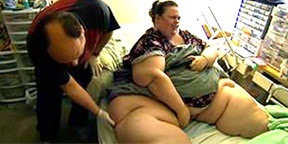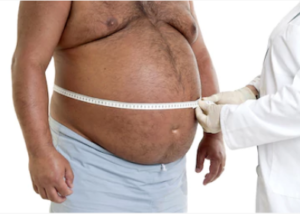
Some say weight doesn’t determine health. But what if someone’s so heavy they waddle?
Is waddling an indicator of something being wrong?
“We need to look at the mechanics of a normal walking style or gait,” begins Dr. David Beatty, MD, a retired general practitioner with 30+ years of experience and an instructor of general medicine for 20+ years.
“To take a step we flex the hip, bend the knee and dorsiflex (bend up) the ankle.
“The foot is placed on the floor, and all the joints straighten out as the leg pushes forward.
“Anything that interferes with any of these actions can cause the pelvis to tilt more than usual, causing the trunk of the body to move side to side in an exaggerated way. The waddle results.”
The interference can be from a congenital condition, arthritis in the hips, a neurological disorder such as stroke, or injury from an accident.
“The causes of a waddle can be joint pain, limitation of joint movement, muscle weakness or impaired neurological input to the muscles,” continues Dr. Beatty.
“Obesity can aggravate most of these conditions — but can also cause waddling in its own right.”
Morbid Obesity and Waddling
Even moderate obesity can cause a waddling gait.
One of the most common associations with a waddling gait is obesity. We’ve all observed it.
Research has shown that obesity increases the strain on the musculoskeletal system, particularly the lower limbs and the spine.
“Because of the extra weight the obese person is more likely to have to move more of their body mass onto the standing foot when walking, resulting in more of a side to side swaying gait,” explains Dr. Beatty.
“The vast majority of people who waddle will have a medical condition — but they may still be healthy in other respects.”
For example they may have normal blood pressure, the absence of an enlarged heart and arrhythmia, normal kidney function and a normal A1c.
However, that’s a snapshot in a moment of time, and for someone who’s significantly overweight, there’s a very high chance that as they approach middle age (if not sooner), they will have multiple health issues directly due to their weight, or, made worse due to their weight.
As a person’s body weight increases from obesity, their skeletal frame remains the same size, and it doesn’t increase in sturdiness to support steady weight gain from overconsuming food.
Thus, the skeleton becomes more and more strained as obesity persists and especially if it gets more pronounced.
This is why when someone gets heavy enough, they become bedbound. It’s simple physics.

A scene from “My 600 Pound Life” on TLC. The human skeleton just can’t support such extensive mass.
A simple example is that of a basic four-legged chair. If enough weight were piled onto it, the legs would buckle and collapse.
Though this isn’t a true apples-to-apples analogy, it’s close enough to make the point clearer, that substantial heaviness places considerable burden on human joints. We’re not built like dachshunds.
This additional weight can lead to a misalignment of the pelvis and hips, often resulting in a waddling gait.
A study published in Obesity Reviews explains that excessive body weight can cause alterations in walking patterns, leading to an uneven gait due to the increased load on joints and the risk of osteoarthritis (Visser et al., 2018).
Additionally, overweight individuals may have weakened core muscles, which are essential for maintaining balance during walking, further contributing to a waddling walk.
With these facts in mind, we can easily see how waddling that’s caused by obesity is a marker for something very bad going on with the body – even if that person’s blood work is normal (for the time being).
Health Implications of Waddling in Obesity
The waddling in and of itself is not an immediate health threat in a morbidly obese person.
Rather, it’s a visible manifestation of what all that unnatural heaviness can do to the bones and joints.
Waddling even occurs in severely overweight kids. This means their obesity is harming their musculoskeletal frame and joints.
People who waddle due to fatness have an increased risk of developing cardiovascular diseases, type 2 diabetes and joint problems such as arthritis, as discussed in the Journal of the American Medical Association (Mokdad et al., 2001).
Preventing and Treating Waddling from Obesity
Weight loss through a combination of dietary changes and exercise will reduce the waddle and, with enough excess fat lost, eliminate it – unless permanent musculoskeletal damage had already been in place.
However, even if permanent damage is already present, this doesn’t mean that weight loss won’t dramatically improve the situation. Weight loss should still be pursued.
A study published in The Lancet Diabetes & Endocrinology suggests that even moderate weight loss can significantly reduce the load on the joints, thereby improving gait and reducing pain associated with osteoarthritis (Hochberg et al., 2012).
What’s the bottom line?
The statement, “If you waddle you’re not healthy,” carries a lot of weight (no pun intended).
If your overweightness causes you to waddle, this should not be acceptable.
Your medical team can give you tests to rule out causes, if any, that are not at all related to carrying all the extra pounds.
But even if something turns up, such as Parkinson’s disease (Horak et al., 2009), this doesn’t mean that your abnormal gait can’t also be influenced by excessive weight.
It also doesn’t mean that your weight won’t cause musculoskeletal issues in the future.
So even if your physician says you have a condition — unrelated to your obesity — that’s causing you to waddle, you should still put in a relentless effort to get your weight down.
One last point: If you’re morbidly obese but, according to your doctor’s observation you don’t waddle, this doesn’t mean you should stay fat.
“Several cancers are more likely to afflict the obese and, in many cases, the outcome is poorer,” says Dr. Beatty. The lack of a waddle won’t change this medically proven fact.
“Heart disease is more likely,” adds Dr. Beatty. “The heart has to work harder to move the person around.
“Angina, heart attack and heart failure [inefficient pumping] can all be a consequence of carrying too much weight.”
If you don’t have a waddling gait but are still very large, this is NOT predictive of a more favorable health outcome long-term.
 Dr. Beatty has worked in primary medicine, surgery, accident and emergency, OBGYN, pediatrics and chronic disease management. He is the Doctor of Medicine for Strong Home Gym.
Dr. Beatty has worked in primary medicine, surgery, accident and emergency, OBGYN, pediatrics and chronic disease management. He is the Doctor of Medicine for Strong Home Gym.
 Lorra Garrick is a former personal trainer certified by the American Council on Exercise. At Bally Total Fitness, where she was also a group fitness instructor, she trained clients of all ages and abilities for fat loss and maintaining it, muscle and strength building, fitness, and improved cardiovascular and overall health.
Lorra Garrick is a former personal trainer certified by the American Council on Exercise. At Bally Total Fitness, where she was also a group fitness instructor, she trained clients of all ages and abilities for fat loss and maintaining it, muscle and strength building, fitness, and improved cardiovascular and overall health.
.









































